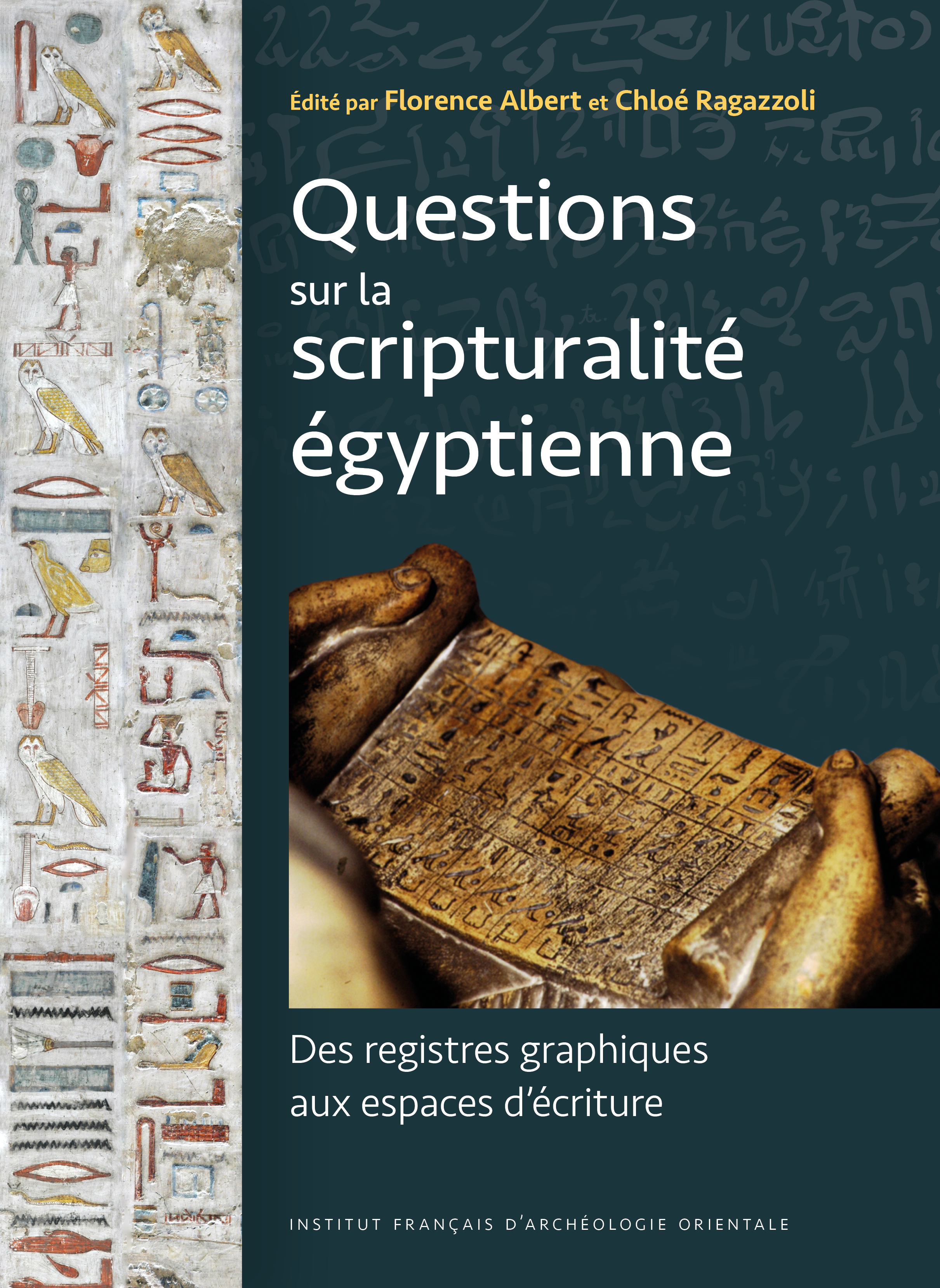Catalogue des publications
Les achats en ligne sont suspendus, sauf pour les fichiers. Retour le 4 janvier 2026. J'ai un code promotionnel.
On line orders are suspended, except for files. Back on 4th of January 2026. I have a promotional code.
extrait du catalogue (recherche de “9782724710892”)
ISBN 9782724710892
2025 IFAO
Collection: BiEtud 192
Langue(s): français
1 vol. 520 p.
127 € (6350 EGP)
Florence Albert (éd.), Chloé Ragazzoli (éd.)
Questions sur la scripturalité égyptienne
Des registres graphiques aux espaces d’écriture
Texte, écritures, livre, qu’ils soient de pierre ou de papyrus, sont des objets culturels dont les définitions, souvent implicites, varient dans le temps et l’espace. Leur articulation révèle des régimes d’écriture où les notions d’auteur, d’œuvre et de scripteur prennent des sens particuliers : les historiciser ouvre de nouvelles perspectives sur la portée, la production, et l'usage des textes. Ce volume présente les pistes suivies collectivement pour saisir la culture de l’écrit et les ressorts de la scripturalité égyptienne, dans le cadre du programme Écritures (Ifao, Sorbonne Université, avec le soutien de l'IUE), consacré à l’archéologie et à l’anthropologie des pratiques d’écriture en Égypte. On trouvera dans ce livre des contributions issues de deux ateliers, organisés en 2019 et 2021, qui ont porté sur la forme visuelle des textes et sur les conséquences en termes de signification et de fonctionnement de leurs différentes mises en espace.
Bilan d’un cheminement réflexif sur les pouvoirs de l’écriture et les éléments non verbaux qui contribuent également au sens d’un texte, les dix-sept contributions de cet ouvrage brossent un vaste paysage de l’écrit, sans cesse reconfiguré, soustrait au regard ou exposé, à travers manuscrits, tombes et matériel funéraire. En examinant les pratiques d’accommodation du produit écrit à travers ses manifestations matérielles, elles proposent des notions – registre graphique, espace scriptural, grammaire spatiale- et explorent des études de cas – manuscrits sur pierre, circulation des textes en contexte funéraire, exposition pariétale d’écriture cursive – qui contribuent à une approche de l’écriture en Égypte ancienne et au-delà, qui prenne pleinement en compte sa dimension matérielle, anthropologique et sociale.
"Text," "writings," "book"—whether of stone or papyrus—are cultural objects whose definitions, often implicit, vary across time and space. Their articulation reveals distinct regimes of writing, where the notions of "author," "work," and "scribe" take on particular meanings; historicising these notions opens new perspectives on the meaning of texts and on their world of production and reception. This volume presents the pathways collectively pursued to grasp the culture of writing and the dynamics of Egyptian scriptural practices within the framework of the Écritures programme (Ifao, Sorbonne University), dedicated to the archaeology and anthropology of writing practices in Egypt. The book includes contributions from two workshops, held in 2019 and 2021, which focused on the visual form of texts through the concept of graphic register, as well as on the semantic and pragmatic implications of their spatial arrangements.
Reflecting on the powers of writing and the non-verbal elements that also contribute to a text's meaning, the twenty contributions in this volume paint a broad picture of writing, constantly reconfigured—whether cursive or hieroglyphic, concealed or displayed—across manuscripts, tombs, and funerary material. Examining the ways in which written products are adapted in their material manifestations, these contributions propose concepts such as graphic register, scriptural space, and spatial grammar, and explore case studies—from stone manuscripts to the circulation of texts in funerary contexts and the parietal display of cursive writing—that contribute to an approach to writing in ancient Egypt and beyond, which fully considers its material, anthropological, and social dimensions.
يُعَدُّ "النص والكتابات والكِتاب"، سواء كانوا من الحجر أو من البردي، أشياءً ثقافية تختلف تعريفاتها الضمنية في كثير من الأحيان باختلاف الزمان والمكان. وتكشف صياغتها عن أنظمة للكتابة، تتخذ فيها مفاهيم "المؤَلِّف والعَمَل والنَّاسخ" معانٍ خاصة؛ ويفتح تأريخها آفاقًا جديدة حول معنى النصوص والظروف المتعلقة بإنتاجها وتلقيها. ويَعْرِض هذا الكتاب السُّبُل المتبعة بصورة جماعيّة لفهم ثقافة الكتابة والدوافع المصرية للطابع الخَطِّيّ الأساسي، وذلك في إطار البرنامج الخاص بالكتابات (المعهد الفرنسي للآثار الشرقية، جامعة السوربون)، المخصص لعلم آثار وأنثروبولوﭼﻴﺎ ممارسات الكتابة في مصر. كما سنجد في هذا الكتاب مساهمات ناتجة عن ورشتيّ عمل عُقدتا عاميّ ٢٠١٩ و٢٠٢١، رَكَّزَتَا على الشكل المرئي للنصوص، والنتائج المترتبة على مواضعها المختلفة من ناحية المعنى والأداء. وترسِم المقالات العشرون في هذا الكتاب مشهدًا موسعًا للكتابات التي يُعاد تشكيلها باستمرار، سواء أكانت الكتابة المختصرة أو الهيروغليفية، مخفية عن الأنظار أو مكشوفة، من خلال المخطوطات والمقابر والمواد الجنائزية، وذلك من خلال حصيلة رحلة تأملية في قُدرات الكتابة والعناصر غير اللفظية، التي تسهم أيضًا في معنى النص. وعَبْر دراسة الممارسات التي يتم من خلالها تكييف المنتج المكتوب في تجلياته المادية، تُقدم هذه المقالات مفاهيمًا تُسْهِم في وَضْع نَهْج للكتابة في مصر القديمة وما بعدها، تأخذ في الاعتبار الكامل أبعادها المادية والأنثروبولوﭼﻴﺔ والاجتماعية؛ مثل السجل التصويري، والمساحة الخطِّية، والقواعد النحوية الخاصة بالمكان؛ كما تستكشف دراسة حالات مثل الكتابة المختصرة على الحجر، وتداول النصوص في السياق الجنائزي، والعرض الجداري للكتابة المتصلة.
- Florence Albert (
: 145084876)
Égyptologue hiératisante, ancien membre scientifique de l’Institut français d’archéologie orientale (Ifao) au Caire, centre particulièrement ses recherches sur la littérature funéraire tardive et ses modes de transmission. - Chloé Ragazzoli (
: 132231360)
Chloé Ragazzoli est égyptologue, spécialiste d’histoire culturelle et des pratiques lettrées de l’Égypte ancienne. Elle est actuellement directrice d’études à l’École des Hautes Études en Sciences sociales où elle occupe une chaire intitulée « Écritures, savoirs, pouvoirs : le laboratoire égyptien » et ses recherches portent sur l’écriture, les scribes, les textes anciens et leur expérience moderne. Elle mène notamment un programme de terrain sur les inscriptions que les scribes de l'Égypte ancienne laissaient sur les monuments qu’ils visitaient.
- Vous pouvez acquérir ce(s) fichier(s) PDF issu(s) de cet ouvrage en cliquant sur le nom du fichier puis 'Ajouter au panier'.
- You can buy theses PDF files extracted from this book by clicking on the file name then 'Add to cart'.


